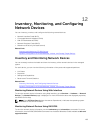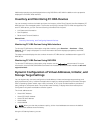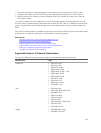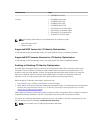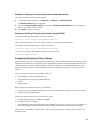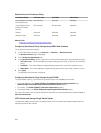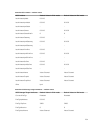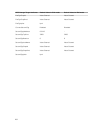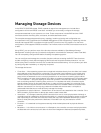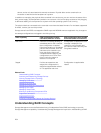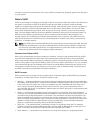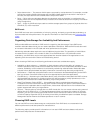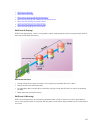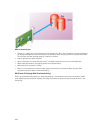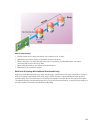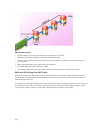13
Managing Storage Devices
In the iDRAC 2.00.00.00 release, iDRAC expands its agent-free management to include direct
configuration of the new PERC9 controllers. It enables you to remotely configure the storage
components attached to your system at run-time. These components include RAID and non-RAID
controllers and the channels, ports, enclosures, and disks attached to them.
The complete storage subsystem discovery, topology, health monitoring and configuration are
accomplished in the Comprehensive Embedded Management (CEM) framework by interfacing with the
internal and external PERC controllers through the MCTP protocol over I2C interface. For real-time
configuration, CEM supports PERC9 controllers. The firmware version for PERC9 controllers must be 9.1
or later.
Using iDRAC, you can perform most of the functions that are available in OpenManage Storage
Management including real-time (no reboot) configuration commands (for example, create virtual disk).
You can completely configure RAID before installing the operating system.
You can configure and manage the controller functions without accessing the BIOS. These functions
include configuring virtual disks and applying RAID levels and hot spares for data protection. You can
initiate many other controller functions such as rebuilds and troubleshooting. You can protect your data
by configuring data-redundancy or assigning hot spares.
The storage devices are:
• Controllers — Most operating systems do not read and write data directly from the disks, but instead
send read and write instructions to a controller. The controller is the hardware in your system that
interacts directly with the disks to write and retrieve data. A controller has connectors (channels or
ports) which are attached to one or more physical disks or an enclosure containing physical disks.
RAID controllers can span the boundaries of the disks to create an extended amount of storage space
— or a virtual disk — using the capacity of more than one disk. Controllers also perform other tasks,
such as initiating rebuilds, initializing disks, and more. To complete their tasks, controllers require
special software known as firmware and drivers. In order to function properly, the controller must
have the minimum required version of the firmware and drivers installed. Different controllers have
different characteristics in the way they read and write data and execute tasks. It is helpful to
understand these features to most efficiently manage the storage.
• Physical disks or physical devices — Reside within an enclosure or are attached to the controller. On a
RAID controller, physical disks or devices are used to create virtual disks.
• Virtual disk — It is storage created by a RAID controller from one or more physical disks. Although a
virtual disk may be created from several physical disks, it is viewed by the operating system as a single
disk. Depending on the RAID level used, the virtual disk may retain redundant data if there is a disk
failure or have particular performance attributes. Virtual disks can only be created on a RAID
controller.
• Enclosure — It is attached to the system externally while the backplane and its physical disks are
internal.
• Backplane — It is similar to an enclosure. In a Backplane, the controller connector and physical disks
are attached to the enclosure, but it does not have the management features (temperature probes,
203



